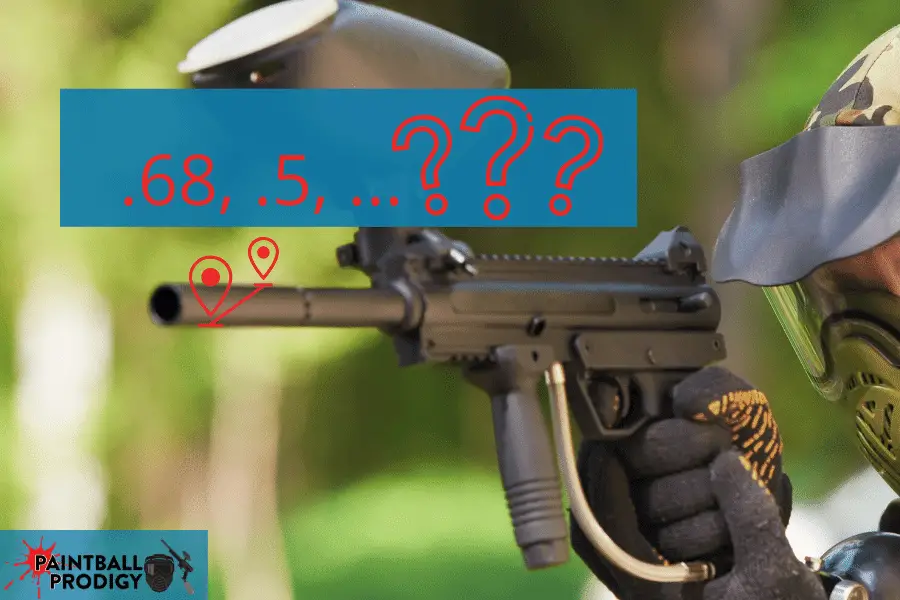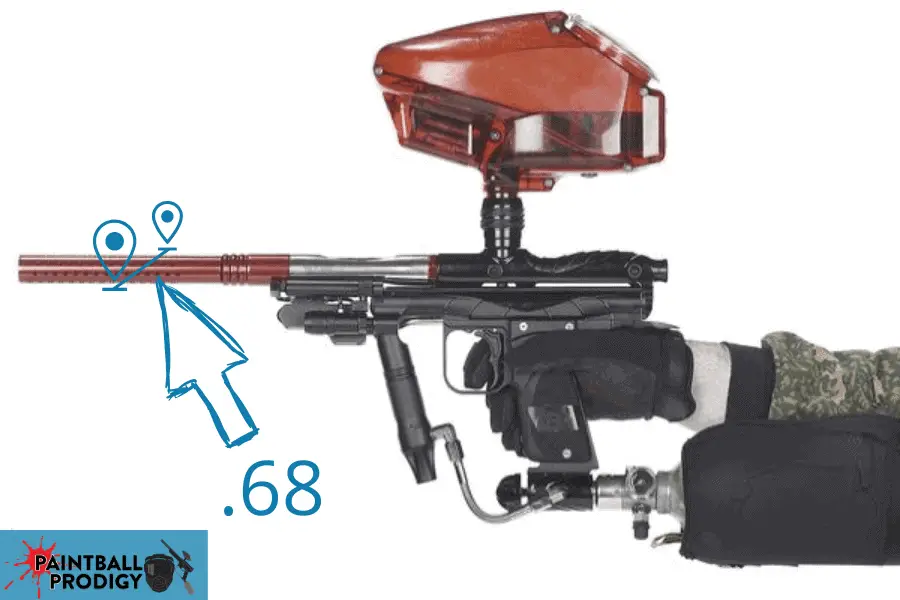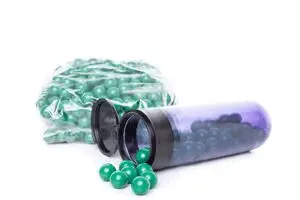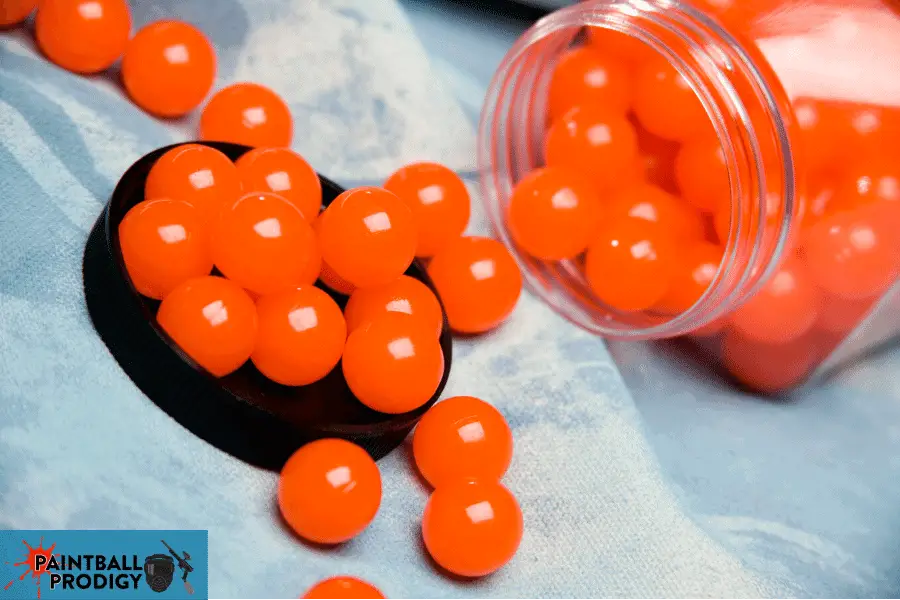Paintball is a fun way to spend time with your closest friends, but you won’t exit the playing arena without experiencing at least a little pain. What you may have noticed over the years is that the amount of pain you feel with each paintball isn’t always the same.
The most painful type of paintball will be high caliber and difficult to break on contact. That makes .68 caliber and reusable paintballs most painful overall. For less painful options, you’ll want to go with lower caliber paintballs, like .50 caliber, an202d paintballs that break easy, like tournament paint.

You may have heard that certain caliber paintballs are better than others, but that’s about it. You’re going to want to learn about what role the caliber of a paintball has in determining the amount of pain caused on impact and improvement in your performance.
Don’t want any hassle? This Paintball set, available on Amazon is great for beginners and you will be ready to play (you still need to have paintballs and fill the paintball tank of course).
Paintball Gun Calibers: What It Means
Most paintball guns come with a .68 caliber design, meaning they can support .68 caliber paintballs. But, if you’re a beginner, that might not mean all that much to you! That’s why we’re going to go over what “caliber” actually means.
It’s also important that you understand how the caliber of paintball determines the force and speed of the paintball as it exits your paintball gun. In doing so, we’ll break down all the information you need to make an educated choice in terms of your next paintball gun!
What the “Caliber” Means
There’s a huge range when it comes to the caliber of the average paintball gun. For the most part, paintball guns usually range from .43 to .68 calibers.
So, what does that mean exactly?
Well, the caliber of a paintball gun describes the actual diameter of the barrel. That means a .68 caliber paintball gun has a barrel measuring .68 inches.
The caliber of your paintball gun will determine the caliber of the paintballs you can actually use with the gun. The larger the caliber, the large the paintballs that you’ll be using at your next match up!

How Caliber Impacts Performance
It’s important to think about how caliber impacts the size and structure of a paintball specifically. Not all paintball calibers are the same when it comes to force and speed.
Take a look at how the caliber of your paintball gun and your paintballs will impact the force and speed of the paintballs as they’re barrelling toward your opponent.
- Velocity. The smaller and lighter a paintball is, the faster it exits the paintball gun and reaches its eventual target. That means that lower caliber paintball guns are great in terms of accuracy, especially when it comes to an opponent in motion. Higher caliber paintball guns don’t eject paintballs nearly as fast.
- Impact. There’s a lot that goes into the physical impact experienced by a paintball after the trigger is pulled. With less amount of force needed to propel a high caliber paintball from the gun, there’s ultimately more of an impact with higher caliber paintballs. This can affect the pain felt when you’re hit by one.
- Breakage. Both the velocity and impact will affect the ability of the paintball to break upon contact. A paintball traveling at a high velocity with heavy impact will break immediately on contact. The lower the speed of the paintball, the less likely it’ll break when it hits its target.
There’s not much you can do about the current caliber of your paintball gun. But, understanding the role that the caliber of your gun plays in your performance can help you when it comes to choosing a new paintball gun in the future!
The Relationship Between Caliber and Pain
So, what do the above characteristics of paintball calibers have to do with the amount of pain that you’ll experience when you’re hit by the paintball?
No matter what, you’re going to feel a little bit of pain when you’re hit by a paintball. The caliber plays a huge role in determining just how much pain you’ll feel when hit!
Here are some ways that the caliber of your paintballs can impact the pain caused by them!
- High velocity doesn’t always mean a lot of pain. When a paintball is traveling toward you at a high speed, it has a greater chance of breaking as soon as it hits you. Though you’ll definitely feel some sort of pain when this happens, the fact that these are smaller paintballs of lower calibers makes them much less painful when they hit your skin.
- Impact plays a huge role in pain. It’s not about how fast you’re hit as it is about how hard you’re hit. With a higher caliber paintball, there’s a larger impact area and thus more pain that develops.
- Lack of breakage is the biggest factor in determining pain. Getting hit with any object or paintball is bound to hurt. But, the idea of the paintball breaking easily on impact reduces the amount of pain associated with the hit. That means lower speed paintballs not making contact hard enough to break will be the most painful, by far.
Basically, the higher the caliber of paintball, the more likely it is to hurt when you’re actually hit with one!
Ranking Paintball Calibers: Least to Most Painful
Now that you know what calibers are and how they impact your performance, it’s time to get down to the nitty-gritty: The pain. We’ll spend a little bit of time going over each of the available paintball calibers and just how much they affect the pain of being hit by one.
By the end of this section, you’re going to know exactly which paintballs to use if you’re a beginner and which paintballs to buy if you want to inflict the most amount of pain on your opponents! Here’s a ranking of the pain caused by paintball calibers from least to most painful.

Lower Caliber
You might not know it, but there is a wide array of paintball gun calibers out there. In fact, some paintball guns boast an impressively small .43 caliber barrel.
The lower the caliber, the less likely you are to experience pain when you’re hit by the paintball! That makes low caliber paintball guns great for beginners or those with an extremely low tolerance for pain.
The greatest risk that comes along with the lower caliber paintball guns is the availability of equipment and options. Because they’re much less common, it might be harder to find paintballs that work with your gun or finding a high-quality gun in general.
.50 caliber
This is one of the more common caliber paintball guns, but not nearly as popular as the .68 caliber paintball gun. Many consider this caliber to be more of a “low impact” type of paintball gun, though that really depends on your personal pain tolerance.
They’re much more likely to travel at lower speeds, make less of an impact, and break on contact. That makes these an incredible and more painless alternative to the typical .68 caliber paintball gun that you’re probably already used to!
.68 caliber
As we mentioned earlier, the higher caliber paintballs are considered the most painful. What you might not realize is that the average paintball gun and paintball are .68 caliber, meaning you’re probably already playing with the most painful paintballs possible!
These are the largest possible paintballs you can use, which also makes them most likely to cause pain. A majority of the pain is caused by the physical size of these paintballs.
Not much larger than the .50 caliber paintball, these paintballs still can travel at relatively high speeds and cause an immense amount of pain on contact. If the paintball doesn’t break when it hits you, it’ll be even more painful!
Paintball Types: What It Means
As a recreational paintballer, you might not know that there are quite a few different types of paintballs out there. You’re probably used to using recreational paintballs, but there are also tournament-style and reusable paintballs as well.
In this section, we’ll go over the major differences between the different types of paintballs and how each can possibly impact pain. By the time you’re done reading this section, you’ll know exactly which type of paintball you should be gathering before your next match up!
The Different Types of Paintballs

You probably just go to the store and pick up recreational grade paintballs without a second thought. Yet, there are three major types of paintballs that can all impact your performance and your experience while playing.
Here’s a look at the different types of paintballs and what sets them apart from one another.
- Recreational grade paintballs. These are the most common types of paintball used by the average recreational paintballer. They are much more cost-effective than the other types of paintballs and usually will break on contact like they’re supposed to.
- Reusable paintballs. These are the best type of paintball for anyone considering themselves to be environmentally-friendly or looking to cut costs in the long-term. This type of paintball is great for practicing without wasting paintballs before the game or match officially starts.
- Tournament grade paintballs. These are, by far, the highest quality paintball on the market. They’re designed to break immediately on impact and have a much thinner exterior shell than other types. These also happen to be the most expensive type of paintball on the market.
As you can see, each type of paintball has its own benefits, specifically when it comes to performance. Yet, each one plays an extremely different role when it comes to pain!
The Relationship Between Type and Pain
As we mentioned when we were reviewing how the caliber of the paintball impacts performance, we briefly touched on the concept of breakage. Here’s how that makes a difference in terms of the amount of pain you’ll feel when you’re hit by a paintball.
- The easier it breaks, the less painful it is. When you have a thin-shelled paintball, it breaks immediately on impact. That’s because less force is required to cause it to break open and release its paint. The thinner the shell, the easier the paintball will break and reduce the impact and pain associated with it.
- The thicker the shell, the more painful it is. This follows the same idea. When a paintball traveling at a rather quick speed makes contact with your body but doesn’t break, your body gives with it. That means the paintball digs into your skin and muscles a little bit more, making you more likely to develop a bruise or injury upon contact.
- If it doesn’t break at all, it’s going to hurt a lot! Most paintballs are designed to break, but some are considered reusable. That means they won’t break at all, no matter how hard you’re hit. Based on that idea alone, they’re much more likely to cause a lot of pain, as they don’t break and simply deflect off of the body.
It’s not necessarily about the brand as it is about the grade of paintball that you’re using. If you want a more pain-free experience, you should lean toward buying paintballs that have thinner shells and break easier when you’re hit!
Ranking Paintball Types: Least to Most Painful
Now that you know a little bit about the different types of paintballs, it’s time to get back to the pain factor. Each type of paintball has its own benefits in terms of usage and performance, but each also inflicts its own amount of pain.
In this section, we’ll go into what makes each of these paintballs so painful. Then, you can make your own choice on which to purchase for your next game. Here they are, the different types of paintballs from least to most painful.

Tournament Grade Paintballs
Tournament grade paintballs aren’t designed to cause pain as much as they’re designed to release paint upon impact. That makes it easier to figure out who’s been hit and eliminated from the game.
In order to guarantee that the paint definitely shows on an opponent’s gear, these paintballs are made with an extremely thin outer shell that guarantees that it’ll break when it hits your opponent.
As we mentioned earlier, breakage plays a vital role in determining how much pain is caused when hit by a paintball.
Tournament grade paintballs cause the least amount of pain because they have thin outer shells that break immediately on contact but are also made of high-quality material that guarantees breakage and consistent performance.
Recreational Grade Paintballs
Recreational grade paintballs are the typical run of the mill paintball that you’re probably already using when you’re playing against your friends. With recreational grade paintballs, you’re going to spend a lot less money than you would with tournament paintballs, but your performance won’t be as great!
Recreational grade paintballs typically have a thicker outer shell than tournament grade paintballs. That means it wouldn’t be unusual for a recreational paintball to not completely break upon hitting your opponent.
With a lower chance of breakage, there’s a greater chance of experiencing more pain when hit by a recreational paintball!
With a lower cost, you’re also getting somewhat of a lower quality product. It’s pretty common for recreational paintballs to come in odd sizes and shapes, making it very likely that they might negatively impact your performance when playing.
Reusable Paintballs
Reusable paintballs are perfect for practice or maintaining a consistent supply of paintballs, but the fact that they’re reusable makes them very likely to cause an immense amount of pain when you’re hit by one!
Without a paint filling and no breakage upon impact, these reusable paintballs will bounce right off of you when you’re hit. But, because they weigh a little more than the average paintball, they’re also more likely to cause pain.
You might be cutting costs with reusable paintballs, but you might not want to invest in these paintballs for use during gameplay. They’re very likely to cause intense bruising when you’re hit by them, so it’s best to avoid them when you’re playing against others.
Moving Forward
Now that you know a little bit more about paintball calibers and types, you can make more informed choices in the future when it comes to purchasing new equipment. You’ll be able to weigh your desired performance and your pain tolerance when choosing the perfect equipment.
We also know that it’s inevitable to experience some sort of pain when playing paintball. That’s why we’re going to briefly touch on things you can do and equipment you can wear to reduce the amount of pain that you experience while playing paintball.
Why The Pain Matters
You might be thinking that the pain comes with the territory. If you want to play paintball competitively, you have to be prepared for the pain that comes along with it.
However, there are a lot of risks that come along with pain from playing paintball. They include:
- Reluctance to play. If you begin to realize that paintball is painful, you might be reluctant to play. What’s the sense in playing if it’s just going to lead to more bruises and pain?
- Severe injury or health consequences. Most paintball injuries are simple bruises or welts, but they can take a turn for the worse depending on where you’re hit. Getting hit in the eye or in the head can cause serious injury and might require actual medical attention.
- Unwillingness to cause pain to others. You might be able to take the pain, but knowing you’re causing pain to others might make you uncomfortable. You should do whatever you can to reduce the amount of pain you might be causing.
Just because paintball comes with pain doesn’t mean you have to enjoy it. In fact, you should be taking your own measures to reduce the pain that you’re causing or experiencing while playing paintball.
The Ideal Equipment
If you’re looking to capitalize on performance and step up your game during your next big match, it would help to make sure that you have the best equipment. Here’s what you should think about in terms of paintballs.
- Choose the highest caliber available. Most paintball guns in 2023 are actually .68 caliber, meaning you’re much more likely to have a greater number of options when it comes to purchasing a new paintball gun. A higher caliber gun will also enable you to improve your performance and get off some more powerful shots than a lower caliber gun would allow.
- Consider the cost of paintballs. All you really need to play recreational paintball is recreational grade paintballs. They’re extremely cost-effective and usually do what they’re supposed to do. Yet, they do have their limits, and tournament grade paintballs are much more likely to break and cause less pain on impact. If you’re really worried about the pain factor, you should consider spending a little more on tournament grade paintballs to reduce pain caused.
- Get some additional gear. Pain is just a part of the game when it comes to playing paintball. In order to improve your performance and lower your risk of experiencing pain, you should get heavy-duty paintball gear.
For the best performance, the highest caliber paintball gun (.68 caliber) would be the best choice. There’s no real difference between the different types of paintballs other than their cost, likelihood of breaking, and the consistency of their shells.
Reducing the Pain With Gear
There’s no doubt that paintball is painful, but there are some steps you can take to guarantee less pain during your next match. Here are some things you should think about in terms of stocking up on the right equipment.
- Wear a mask. The only thing worse than getting hit by a paintball on your body is getting hit by a paintball on the face. By selecting a high-quality mask that covers all areas of your face, you’re much less likely to feel any pain if a paintball travels toward your head. You might feel a little impact, but it’ll quickly bounce right off without leaving a gnarly bruise on your face.
- Dress in layers. This is probably the best way to reduce the amount of pain when you’re playing paintball. When you add more layers to your paintball attire, the impact of the paintball is more likely to be absorbed by the multiple layers of clothing. Though you’ll still feel the impact slightly, it’ll be much less painful and you’re much less likely to wake up the next morning with a bruise or a welt.
- Getting stronger. You might not even realize it, but the physical composition of your body plays a huge role in how much pain you feel when hit by a paintball. By greatly improving your muscle mass and reducing the amount of fat all over your body, it’ll be easier for your body to deflect paintballs as they hit you without absorbing a ton of shock like it does when it hits fat. That means it might be time to start hitting the gym!
- Playing with tournament grade paintballs. We mentioned earlier that the actual type of paintball will determine how much pain you feel when playing. If you use tournament grade paintballs, the paintball is guaranteed to break upon impact and definitely won’t cause as much pain as a regular paintball would. You’ll have to spend a little more money, but it might be worth it if you tend to bruise easily.
- Reconsider how you view pain. You might not even realize that your perception of pain is mostly psychological. That means that your body might physically feel the pain, but how badly it affects you will depend on how you perceive it. By shifting your viewpoint and perception of pain, you can reduce just how much pain you feel every time you’re hit by a paintball!
You can’t take the pain out of the game completely, but there are a lot of things you can do on your own to make the game at least a little less painful and a lot more enjoyable.
Anybody who’s interested in getting into paintball but has a lower tolerance now has plenty of options when it comes to getting into the game without all the negatives that come along with it!
Conclusion
If you’re the type of paintballer that just buys whatever paintballs are cheap or considered “high-performance,” you might want to reevaluate the criteria you base your next purchase off of! Each type of paintball has its own pros and cons, but also its own pain factor associated with it. Here’s a brief summary of the paintball calibers and types and the pain they can cause!
- The higher the caliber, the more painful the paintball tends to be, which is why .68 is considered the most painful.
- Reusable paintballs are known for being most painful, with the least painful being high-grade tournament paintballs.